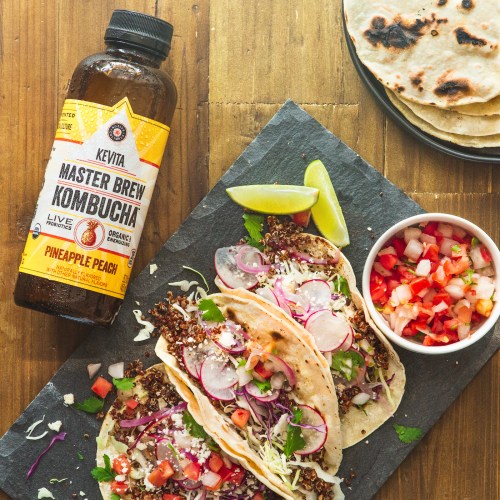advertisement
Why giving your taste buds something new can be good for you—in more ways than one
It's hard to branch out from your everyday meal staples—but did you know trying new foods could actually be better for your overall health?

If you’re a creature of habit (guilty), your eating routine is probably down to a scripted science: meal prep, eat, and repeat until you finally decide you’re over it. Trying new foods on the reg? Not necessarily on the menu.
There’s a reason why so many people repeat the same rice, chicken, and broccoli combo, though: Routine provides a sense of control and order. And while peace of mind is an obvious “yes please,” getting creative and outside of your comfort zone could do more for you.
First, a little science: Research shows that your taste buds send neurochemical signals to your brain communicating sweet, salty, sour, or umami (savory) flavors. Your taste receptors have about 10 different levels of sensitivity, which means we can taste up to 100,000 flavors (yep, there’s a whole wide world out there). At the same time, taste buds can change or diminish as you age—which means that something you previously found too intense, you suddenly might not be able to get enough of.
Translation: Now is a good time to try something new. “Exploring new foods and drinks can be beneficial to your health because consuming a wide variety of nutrients from varied sources helps your body function at its best,” Juhy Ali, RD says.
Speaking of richer experiences, try starting with something specific like KeVita’s delicious probiotic drinks. From Master Brew Kombucha to Sparkling Probiotic Drink, they come in tons of flavors like Mojita Lime Mint Coconut, Pineapple Peach, and Turmeric Ginger with billions of live probiotics—the micro-organisms often referred to as good bacteria because they can work with your gut microbiota to break down non-digestible components of your diet and produce beneficial substances that can convert into energy.
Interested to start trying new foods and sips? Keep scrolling for 3 easy ways to add different flavors to your repertoire.
1. Add them to meals you already love
While your preferences are of course tied to your taste buds, a lot of what we think we like has to do with cultural context. In other words, you might be scarred from having to eat Brussels sprouts as a kid or might find an unfamiliar spice unappetizing just because you’re not used to it.
One way around that? “When trying new foods, pick […] something that you can pair with something you already really like,” recommends Caroline Brantley, RD. “Can you blend spinach into a smoothie or add minced vegetables into a sauce or mac and cheese?” Pro tip: Add kombucha to your salad dressing to give a kick to your go-to bowl of greens.
And Ali agrees that changing the context of your mealtimes could change your flavor experience. “Start by incorporating items slowly,” she says. “Add a new vegetable to a family-favorite chili recipe. The chances of enjoying butternut squash in a familiar food is higher than if you were to roast it on its own with salt and pepper and have it as a side for your first time.” Bonus points if you pair it with a new-to-you (and flavor-packed) bev, like in this recipe.

2. Go for variety
Use this as your new mantra: Trying new foods and drinks can also be about giving yourself more nutrition variety. “Expanding your palate with different colors and food groups can help provide a nutrient-dense diet,” confirms Brantley.
For example, “One cup of white rice can provide 4 grams of protein, but replace that rice with quinoa, and you’ll get double the amount of protein,” says Ali. And you can upgrade your beverage line-up, too.
On that front, try stocking your fridge with KeVita Sparkling Probiotic Drinks for a lightly carbonated pick-me-up, Master Brew Kombucha for a pleasantly tart punch of organic caffeine, or Apple Cider Vinegar Tonic as a sweet and tangy way to get two tablespoons of apple cider vinegar. All three drinks provide billions of probiotics, so it looks like you’ve already got three soon-to-be-faves in the bag.
3. Try preparing new-to-you foods different ways
Not to bring up the Brussels sprout incident again, but preparing ingredients you previously loathed in a different way could change the entire game for you. “Vegetables can be steamed, roasted, sautéed, incorporated into sauces, served in a salad, or even blended in a smoothie,” advises Brantley. In addition, she recommends adding different spices and seasonings to help you see new foods in a different light.
No disrespect to your chicken-broccoli-rice staple, but by trying new foods and drinks you may usually stray away from, you can embark on a full-on flavor quest. “It not only opens up your mind, but [can] expand your palate,” says Ali. And when all else fails, remember this bit of wisdom from Brantley: “Trying new foods [and beverages] can be scary or intimidating, but you’ve got nothing to lose.” Comfort zone, where you at?
Sponsored by KeVita
Top photo: Ivan Gener/Stocksy
The information in this article is the opinion of the author(s) and in no way reflects the policies or positions of KeVita. This is not intended to be a substitute for professional medical or nutrition advice.
Sign Up for Our Daily Newsletter
Get all the latest in wellness, trends, food, fitness, beauty, and more delivered right to your inbox.
Got it, you've been added to our email list.




